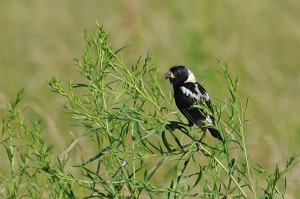
From bobolinks flushing up from a grassy field to the beautiful song of an eastern meadowlark, grassland birds greatly enrich summer in Vermont. But many of these species are in decline due to the loss of appropriate grassland habitat.
Landowners can make a difference by altering the times of year they mow fields that are 10 acres or larger. The Vermont Fish & Wildlife Department and Audubon Vermont are encouraging landowners to help promote these beloved species by waiting a little longer to mow and give these birds a chance to complete their nesting season.
“People maintain large fields and meadows in Vermont for a variety of reasons, from commercial hayfields and grazing pastures, to simple aesthetic beauty,” said Steve Parren, biologist for the Vermont Fish & Wildlife Department. “Mowing is the most common means of maintaining the grasses but if mowed too soon in the summer, many grassland bird species will lose their nest and any hatchlings."
Bobolinks build nests from May through July among the grasses and wildflowers of fields and meadows. When bobolinks are present, other grassland bird species such as savannah sparrows and grasshopper sparrows, may also be nesting among the grasses. Deer fawns, wild turkey chicks, and other animals take refuge in the grass, and are also at risk by mowing too early.
According to Parren, landowners who mow their fields for aesthetic reasons can maintain these fields and accommodate the nesting birds simply by cutting after August 1. Farmers and other landowners who use the grass for hay can follow a regime that protects nesting grassland birds, including cutting before June and then waiting at least 65 days, or around August 15 to cut again. For farmers who maintain commercial hayfields and grazing pastures, Audubon Vermont coordinates the Bobolink Project in association with Mass Audubon, the University of Vermont, and several other partners. The Bobolink Project uses donated funds to provide financial assistance to participating farmers who modify their mowing schedules so that grassland nesting birds can successfully raise their young. This year, they are working with 15 farmers to protect more than 839 acres of grassland habitat.
“Birders and farmers both care about birds. The Bobolink Project is a great way for the general public to help support grassland bird conservation,” said Mark LaBarr, conservation program manager, Audubon Vermont.
For more information, go to www.bobolinkproject.com or for landowner management assistance, see www.vtfishandwildlife.com.
For Immediate Release: June 3, 2019
Media Contacts: Mark LaBarr, Audubon Vermont, 802 434-3068; Steve Parren, VT Fish & Wildlife, 802-371-7142
